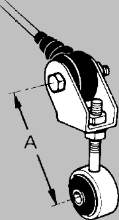There seems to be a lot of conflicting posts the LSPV because there are two possible ways of doing the adjustment.
In most of the posts, it seems that people want to adjust the "shackle" side of the LSPV. This is the side that's connected to the axle.
In the Toyota FSM, they tell you to adjust the "valve" side of the LSPV. This is the side that's connected to the frame.
If you adjust the shackle side, you'd send it up after a lift. If you adjust the frame side, you'd send it down after a lift.
I'm planning on doing the FSM recommended adjustment, and am going to weigh my rig and test the brake pressure. The way I see it, Toyota's recommended method sets a reasonable distribution of pressure for a moderately loaded vehicle. It appears to be a very sensitive adjustment, and screwing up by a few milimeters likely reduces braking effectiveness.
I am going to make one small modification to the recommended process.
The best numbers I've found indicate a stock 94 (the best landcruiser ever)

weighs 5300 lbs, with 2756 of it in the front and 2544 of it in the back. The LSPV adjustment is done with about 388 lbs of additional weight in the back.
The problem with adjusting after a lift is that the springs are stiffer, so there is going to be less movement per pound. If you do the adjustment exactly as recommended by toyota, your back brakes will be over utilized when you're empty and under utilized when you're loaded, i.e. the valve is under-compensating. If you're running with exactly 388, then you'd still be perfectly balanced, since that's where you took the measurement.
Since I'm more concerned with braking when I'm loaded, I'm going to do the adjustment with a bit less weight on the back axle. This means that I'll be over-utilizing my back brakes when I'm light, but will be using them more effectivley when I'm over 388 lbs and really need them.
I'm going to determine the amount of weight by comparing the stock suspension movement when adding another 200 lbs to the 388 lbs vs. the OME suspension movement when adding another 200 lbs to the 388 lbs.
If it's pretty close, I'll stay close to 388 lbs for the adjustment.
If it's around half, then I'll do the adjustment with about 188 lbs. If I do that, the LSPV will compensation will be 1/2x(load) + 200. The 1/2 compensates for the 1/2 movement per pound, the 200 compensates for the imaginary 200 lbs i added by calibrating with 200 lbs less weight.
This means the braking sweet spot where everything is balanced will be at 588 extra lbs over the rear axle.
Instead of doing this with 1/2, I'll use the actual ratio of suspension movement between OEM and OME.
I'll measure anyway and see how close it comes to the rules of thumb that are out there.
OK.. time to go find another beer.
Tom



